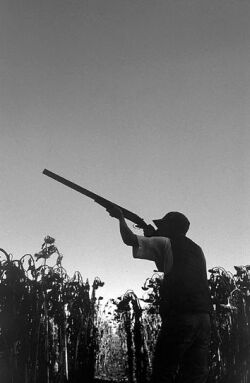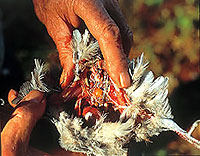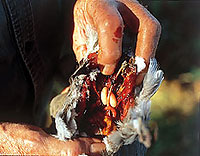 Doves are our most ubiquitous and popular gamebird. In Zimbabwe, more doves are shot than any other species and in recent years this activity has increased in popularity. This seems to be because of the ready availability of ammunition and the ease with which shooting spots can be found, close to urban centres. Hunting habits and trends have also changed over the years, possibly also in response to changes in structure of gamebird populations - fewer waterfowl and groundfowl available? Doves are our most ubiquitous and popular gamebird. In Zimbabwe, more doves are shot than any other species and in recent years this activity has increased in popularity. This seems to be because of the ready availability of ammunition and the ease with which shooting spots can be found, close to urban centres. Hunting habits and trends have also changed over the years, possibly also in response to changes in structure of gamebird populations - fewer waterfowl and groundfowl available?
Thirty years ago dove shooting was hardly mentioned. Although they are widespread and encouraged by the intensification of agriculture, we know very little about this gamebird group and how changing land use and hunting has influenced them. It has been suggested that doves are sufficiently numerous and resilient, that they should not be affected by timing of hunting in relation to breeding or in numbers shot and are the bags that are reported to be shot today, sustainable? It is rumoured that 2000 to 3000 doves are bagged per day by foreign hunting clients, guided by local safari operators. Why should it be different to the European Turtle Dove for example which has declined by 75% over the last 30 years?
In the last publication I discussed the same issue; that of responsible use and ethics in the context of sandgrouse hunting. Doves are affected in a very similar way in terms of hunting and breeding, although they are much more numerous in both diversity of species and population size. Doves also have distinctive biological characteristics, although they are largely overlooked and hardly studied in Africa.
Doves in our region are sedentary; that is they do not migrate and generally are not nomadic. This contrasts with some north American and European species which are migratory, moving in response to climate and nomadic, a feature of semi-desert and desert regions where birds move in search of food and water. This is typical of birds in the sub-tropics and even further south of us, where winters are mild and food supplies available all year. Doves are capable of moving long distances, due to large and well-developed breast-muscles and fine homing and navigational instincts. Most ringing recoveries are in the region of ten kilometres in the case of Laughing and Cape Turtle doves (Streptopelia senegalensis, S. capicola). Red-eyed doves, the larger of the doves (Streptopelia semotorquata) appear to move greater distances - of the order of 80 kilometres. These distances however, have been inferred from ringing recoveries which indicate distances covered in most of the lifetime of the birds rather than daily movements which are probably much less. Daily movements appear to be short, probably of the order of two to five kilometres. This means for the most part, that landowners and hunters are largely responsible for their own actions where the effects of hunting are concerned.
Let us consider other aspects of their biology which relate to harvesting. They are monogamous, pairing for life according to one source. Like sandgrouse, if one of a pair is shot during breeding, the whole clutch or brood is likely to fail. They also produce only two eggs and often rear only one chick. This is probably because their nest is a flimsy structure from which eggs and chicks are easily lost. Conversely they are probably capable, as long as food and conditions are favourable, of breeding several times a year. But how many of the population will do this?
Like most of our gamebirds, they breed most actively during the dry winter and spring months rather than during the summer rains. Most reports show peak breeding to be in the spring months of August to October, but also in the winter and to a lesser extent, during the rains. The information I have collected suggests that almost every bird shot over crops is breeding from the end of the rains. In summary, doves will breed at any time of the year but mostly in the cold, dry and hot dry months. As long as it is dry and food available, doves will breed. This appears to be contrary to popular belief that doves only breed during the rains when there is no shooting.
 |
 |
| The gonads of a female Red-eyed dove showing an enlarged ovule (left). The gonads of a male Red-eyed dove showing very enlarged testes (right). The above are indications of breeding condition.
|
Shooting takes place when the birds flight to ripening crops in April and May; crop residues after this until rains in October, and onto germinating crops at the beginning of the rains in November and December. When surface water becomes less widespread from August to October they are also shot flighting to water. Hunting, therefore, because it is concentrated during the breeding season could have a major impact, but it is not known how important this is. In temperate areas inclement weather (cold) and a range of other factors are likely to influence populations to a much greater extent than hunting. In a study on doves in North America, the greatest cause of death was cold weather and collision with obstacles, particularly telephone and power lines. Survival of progeny is good when compared to sandgrouse for example. Around 38 - 50% of eggs laid will fledge, of which an unknown number survive to maturity. Given these figures it can be seen that survival is not as high as one might expect.
Doves are relatively long lived. In captivity they can live up to 35 years, although in the wild ten years is normal. Longevity is a factor which influences fecundity, and in the case of doves which have a long lifespan, longevity should contribute towards survival if they breed throughout their life, but typically birds which have a long generation interval have low fecundity rates. Although the dove species are widespread and numerous, it is not inconceivable that they could be locally depleted to a level where they no longer offer sport, and there are indications of this around Harare.
It is difficult to prescribe hunting management recommendations which might favour doves because very little is known about them. The best advice to hunters is to be moderate in the numbers killed. Landholders and Safari Operators could also play a role by limiting numbers of birds shot. A limit of 50 birds per person is a reasonable number to shoot in a single shooting sortie. Rumoured bags of 2000 - 3000 doves a day, by even a large group of hunters seems unreasonable. Above all, birds which are shot should be eaten and not wasted.
Most of the indications are that dove shooting is recommended during the winter; June, July and early August and during the rains from December through March when breeding is at its lowest.
Traditionally however, this is not the sporting season and doves do not flight in the numbers that they do in the late summer and winter months.
It would be helpful if Zimbabwean hunters and safari operators would forward shot sandgrouse for dissection to myself in Harare, Ron Hartley at Falcon College, Esigodini or to Peter Mundy, the Department of National Parks & Wildlife Managementsí ornithologist at Bulawayo. This would be particularly useful for sandgrouse shot early in the season. They should be frozen and the whole bag submitted if possible. It would be useful to know the sex ratio of the bag because a skewed sex ratio may allude to breeding activity. Males are easily differentiated by the bands on the breast.
Charles Mackie
WWF SARPO
P.O. BoxCY 1402
Causeway, Harare
Email: cmackie@wwf.org.zw
|
|